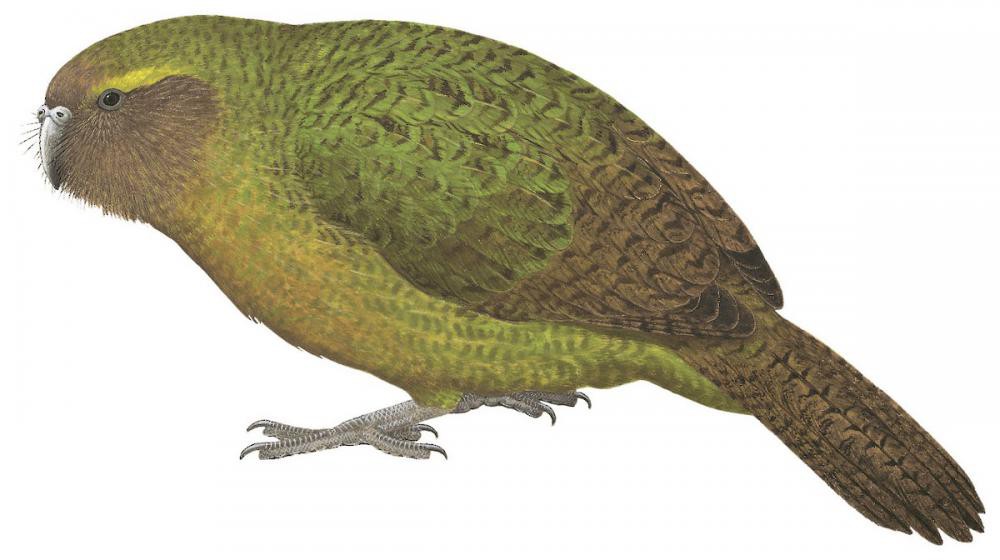Kakapo / Strigops habroptila

Kakapo
SCI Name:
Protonym: Strigops habroptilus Gen.Birds 2 p.427 pl.CV
Taxonomy: Psittaciformes / Strigopidae / Strigops
Taxonomy Code: kakapo2
Type Locality: 'One of the islands in the South Pacific'' = New Zealand, restricted to Dusky Sound, South Island by Mathews and Iredale, antea.
Author: Gray, GR
Publish Year: 1845
IUCN Status: Critically Endangered
DEFINITIONS
STRIGOPS
(Strigopidae; Ϯ Kakapo S. habroptila) Gr. στριξ strix, στριγος strigos owl; ωψ ōps, ωπος ōpos countenance; "STRIGOPS. Bill higher than broad, slightly compressed, and grooved on the sides; the culmen much curved to the tip, which is acute; the lateral margins dentated in the middle; the lower mandible with the gonys broad, rounded, and much grooved longitudinally, and the base of both mandibles covered by the basal feathers, with the shaft of each prolonged into hairs; the nostrils basal, lateral, large, and rounded. Wings rather short and rounded, with the fifth and sixth quills equal and longest. Tail moderate, weak, and much rounded, with the end of each feather rather pointed, and the shafts projecting beyond the web. Tarsi short, robust, and covered with rounded scales. Toes unequal, and covered with quadrate scales, except at the end of each toe where the scales are transverse; the claws long, strong, and slightly curved. This remarkable bird was found in one of the islands of the South Pacific Ocean. Its manners and habits are unknown; but, from the appearance of the bill, I am induced to suppose that it feeds on fruits that are enveloped in a strong hard coating. S. habroptilus G. R. Gray." (G. Gray 1845); "Strigops G. R. Gray, Gen. Bds., 2, 1845, p. [426], pl. CV. Type, by monotypy, Strigops habroptilus G. R. Gray." (Peters 1937, III, 141). The very rare Kakapo is also known as the Owl Parrot, because of its owl-like facial discs and soft body plumage.
Var. Strigopsis (Gr. οψις opsis appearance, face), Stringops (Gr. στριγγα stringa owl < accusative case of στριξ strix owl), Stringopsis, Strygops.
HABROPTILA
(Rallidae; Ϯ Invisible Rail H. wallacii) Gr. ἁβρος habros soft, delicate; πτιλον ptilon feather; "HABROPTILA. Bill longer than the head, strong, with the culmen at the base elevated, broad, rounded posteriorly, and gradually descending towards the tip, which is suddenly curved; the sides compressed to the tip, which is slightly emarginated; the gonys moderate, slightly angulated and advancing upwards; nostrils placed in a membranous groove, which extends beyond the middle of the bill, with the opening linear and near the base of the groove. Wings very short, lax, with the fourth to seventh quills equal and longest. Tail very short and lax. Tarsi robust, as long as the middle toe, and covered with transverse scales. Toes rather robust and long; the lateral toes equal, the hind toe moderate and strong. Claws moderate and compressed. Plumage in general very lax. The wings armed at the bend of the shoulder with a small spine. HABROPTILA WALLACII. ... This curious bird approaches the Ocydromi in the shortness and softness of its wings; the feet are those of a Porphyrio. Yet its general appearance might cause it to be taken, at first sight, for a species of Hæmatopus." (G. Gray 1860); "Habroptila G. R. Gray, Proc. Zool. Soc. London, 1860, p. 365, pl. 172. Type, by monotypy, Habroptila wallacii G. R. Gray." (Peters, 1934, II, p. 178).
habroptila / habroptilus
Gr. ἁβρος habros soft, delicate; πτιλον ptilon feather.
UPPERCASE: current genus
Uppercase first letter: generic synonym
● and ● See: generic homonyms
lowercase: species and subspecies
●: early names, variants, mispellings
‡: extinct
†: type species
Gr.: ancient Greek
L.: Latin
<: derived from
syn: synonym of
/: separates historical and modern geographic names
ex: based on
TL: type locality
OD: original diagnosis (genus) or original description (species)












